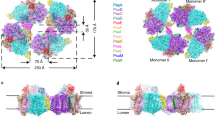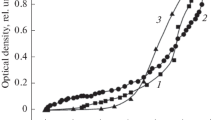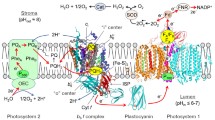Abstract
Spinach chloroplast thylakoids treated in the light with bifunctional maleimides were previously shown to be uncoupled. The increase in proton permeability by these reagents is caused by the cross-linking of an accessible group on the γ subunit of coupling factor 1 (CF1) to a group that becomes exposed to reaction with maleimides only when the thylakoids are energized. In this study, several bifunctional maleimides, includingo-,m-, andp-phenylenebismaleimides, 2,3- and 1,5-naphthalenebismaleimides, and azophenylbismaleimide, were tested for their ability to form cross-links and to uncouple photophosphorylation. These reagents form cross-links from about 6 to 19 Å. Each reagent was found to form cross-links in the light and to inhibit photophosphorylation. However, the effectiveness of these compounds as uncouplers decreased as the distance between the cross-linked groups increased, indicating that the distance between two groups on the γ subunit of CF1 can regulate proton flux through the membrane. Monofunctional maleimides cause a light-dependent energy transfer type of inhibition of photophosphorylation. Although this inhibition was correlated to the reaction of the maleimide with a group on the γ subunit that is exposed only in energized thylakoids, the accessible group on this subunit was also modified by the reagent. However, we show here that the accessible group plays no role in the inhibition of photophosphorylation. This group may be blocked by incubating thylakoids in the dark with methyl methanethiolsulfonate. The light-dependent inhibition of photophosphorylation byN-ethylmaleimide was unaffected by this treatment or by the subsequent removal of the methanethiol moiety from the accessible group.
Similar content being viewed by others
References
Andreo, C. S., Ravizzini, R. A., and Vallejos, R. H. (1979).Biochim. Biophys. Acta 547 370–379.
Arnon, D. I. (1949).Plant Physiol 24 1–15.
Avron, M. (1960).Biochim. Biophys. Acta 40 257–272.
Bruist, M. F., and Hammes, G. G. (1981).Biochemistry 20 6298–6305.
Burke, M., and Reisler, F. (1977).Biochemistry 16 5559–5563.
Erlander, B. F. (1980).Trends Biochem. Sci. 5 110–112.
Fasold, H., Gröschel-Stewart, U., and Turba, F. (1963).Biochem. Z. 337 425–430.
Jagendorf, A. T., and Smith M. (1962).Plant Physiol. 37 135–141.
McCarty, R. E., and Fagan, J. (1973).Biochemistry 12 1503–1507.
McCarty, R. E., and Racker, E. (1967).J. Biol. Chem. 242 3435–3439.
McCarty, R. E., Pittman, P. R., and Tsuchiya, Y. (1972).J. Biol. Chem. 247 3048–3051.
Moroney, J. V., and McCarty, R. E. (1979).J. Biol. Chem. 254 8951–8955.
Moroney, J. V., and McCarty, R. E. (1982).J. Biol. Chem.,257 5915–5920.
Moroney, J. V., Andreo, C. S., Vallejos, R. H., and McCarty, R. E. (1980).J. Biol. Chem. 255 6670–6674.
Portis, A. R., Jr., Magnusson, R. P., and McCarty, R. E. (1975).Biochem. Biophys. Res. Commun. 64 877–884.
Ravizzini, R. A., Andreo, C. S., and Vallejos, R.H. (1980).Biochim. Biophys. Acta 591 135–141.
Reisler, E., Burke, M., Himmelfarb, S., and Harrington, W. F. (1974).Biochemistry 13 3837–3940.
Ryrie, I. J., and Jagendorf, A. T. (1971).J. Biol. Chem. 246 3771–3774.
Ryrie, I. J., and Jagendorf, A. T. (1972).J. Biol. Chem. 247 4453–4459.
Smith, D. J., Maggio, E. T., and Kenyon, G. L. (1975).Biochemistry 14 766–771.
Taussky, H., and Shorr, E. (1953).J. Biol. Chem. 202 675–685.
Weiss, M. A., and McCarty, R. E. (1977).J. Biol. Chem. 252 8007–8012.
Wells, J. A., and Yount, R. G. (1979).Proc. Natl. Acad. Sci. USA 76 4966–4970.
Author information
Authors and Affiliations
Rights and permissions
About this article
Cite this article
Moroney, J.V., Warncke, K. & McCarty, R.E. The distance between thiol groups in the γ subunit of coupling factor 1 influences the proton permeability of thylakoid membranes. J Bioenerg Biomembr 14, 347–359 (1982). https://doi.org/10.1007/BF00743063
Received:
Revised:
Issue Date:
DOI: https://doi.org/10.1007/BF00743063




